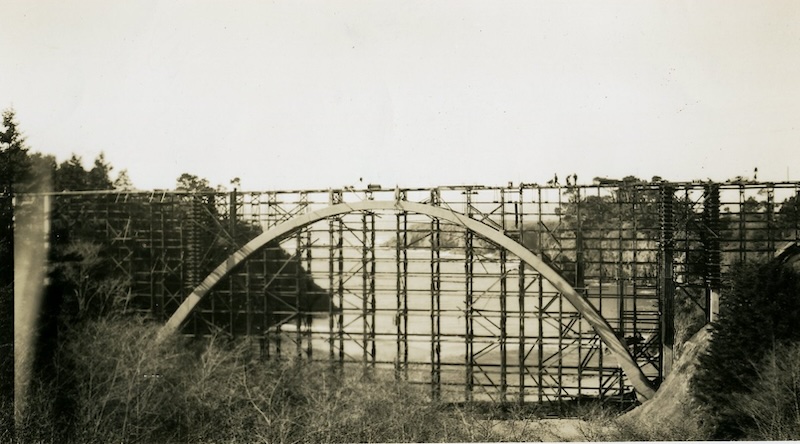June 9, 1940 – California Governor Culbert Olson and Secretary of State Paul Peek spoke at the dedication ceremony for the new bridge over Russian Gulch. Following the speeches by Governor Olson and Secretary Peek, the Governor’s party had the honor of being the first to drive across the newly constructed bridge. Other motorists waited three more weeks for construction to be completed. The bridge opened to the public on June 30th.

Russian Gulch Bridge Under Construction, 1939. (Gift of Emery Escola)
The previous bridge in this location was a timber trestle built in 1911, when automobiles were just starting to become popular on the Mendocino Coast. By 1938, it was clear that the old structure could no longer support the increasing weight of trucks carrying lumber and produce. An inspection by the California Division of Highways, the precursor to today’s Caltrans, identified seven coastal bridges, including the one at Russian Gulch, as unsafe.
The construction of the new Russian Gulch Bridge began in October 1939, spearheaded by the Works Progress Administration (WPA). This New Deal agency, established under President Franklin D. Roosevelt, was instrumental in providing jobs and revitalizing infrastructure during the Great Depression.
The Russian Gulch Bridge was also a success for Frederick Panhorst, the chief of the bridge section of the California Division of Highways from 1931 until his retirement in 1960. Renowned for his ability to complete challenging projects within budget, Panhorst enlisted the expertise of famed bridge designer Henry E. Kuphal. Together, they created a concrete arch bridge that has been celebrated in engineering circles for its beauty and design. Its spectacular Roman Arch is similar in design to the more famous Bixby Creek Bridge further south, but the Russian Gulch Bridge’s arch is supported only by the two rocky headlands on either side without need for buttresses. In recognition of Panhorst’s contributions, the bridge was renamed the Frederick W. Panhorst Bridge in 1975.
BRIDGES, HUCKLEBERRIES, AND ROBIN STEW by Robert Winn. Oral history interviews, newspaper research, and 30 black-and-white photos recount the impact of government building projects and individual initiative during the Depression years on the coast. $15.